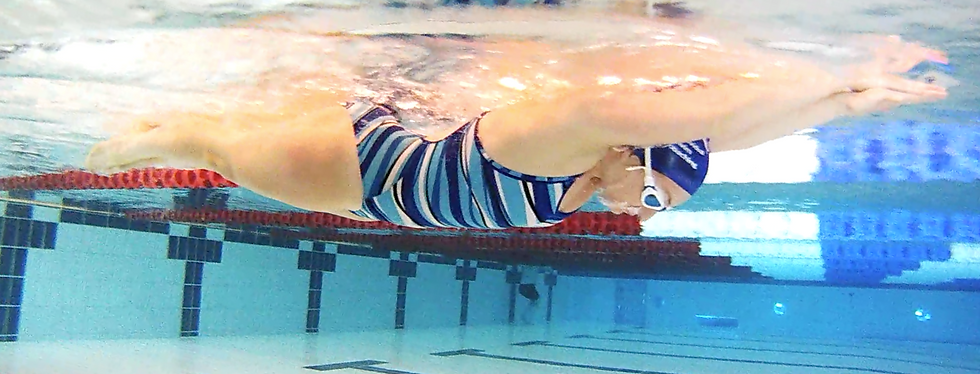Step 1/5 to drastically improve your swimming stroke and speed
- Annie Hollest
- Sep 11, 2019
- 3 min read
Step 1) Minimise your drag by improving your body position in the water

Here you can see the swimmer previously had low lying sinky legs in the water. This results in high surface area moving forwards, causing high drag, slow swimming speed and hard work!
Improving his body position leads to higher legs and therefore reduced surface area travelling forwards in the water and reduced drag, making swimming at a given speed much less effort. I like to get swimmers to visualise swimming 'through a tube'.
It’s so easy to think ‘I must change my positioning’, but how do you actually improve your drag I hear!?

Some athletes incorrectly believe that getting a good push off the wall in the pool is cheating, by reducing the overall swimming volume. Yes, one of the advantages of a good push off the wall is that it can carry you through the water about 5m, or 20% off a standard 25m pool (actually an advantage in pool based triathlons with the accompanying reduced energy expenditure).
A great swimming technique with minimal drag is founded with getting a good stretch through the core and particularly the layer of fascia passing over the muscles. When activated, this fibrous body of webbing keeps all your body tissues, organs and muscles much more connected. These myofascial lines of connection transmit strain and rebound, which facilitate movement while providing stability. Essentially getting a good stretch gives you free energy in the water for a lot less effort, similarly to the way it does in running and cycling.
Another advantage of getting a good push off the wall is setting up the correct body position. A bad push and glide can contribute to sinky leg syndrome. It’s very hard to recover from this if you don’t have a very effective leg kick (not typical for triathletes!). So getting your body streamlined reduces drag and makes it a lot less effort to get to the end of the pool.
You also reduce the likelihood of other stroke faults creeping in when swimming with a good posture, such as arm crossovers in front of the head, which can lead to snaking through the water. This lateral movement means you’re wasting energy going side to side rather than pushing water backwards efficiently to make you go forwards in the water.

Many swimmers hold their breath in the water. This leads to your lungs inflating like a balloon, raising your top end sinking your legs, resulting in very high drag. If you feel like you fight the water, this is most likely the reason why!
Breath holding also leads to storage of carbon dioxide, sending a panic bell off in your brain. Often you’ll interpret this as lack of Oxygen. But if you think about it you’ve just had a breath in about one or two seconds ago and we’re not at the top of Everest; the Oxygen content of your air was perfectly good! Storing CO2 elevates your blood lactate level leading to you reach your lactate threshold very quickly. Ever get to 50-75m and wonder why you’ve got to stop to ‘catch your breath’ or had to resort to breastoke in your triathlons? Get your exhalation right and say good-bye to this performance hump.
How do I breathe out properly to sink down?
If you need to first, try standing face down in the deep end just simply blowing bubbles out your nose and mouth. Ensure you let go of the air with a relaxed face; let your facial muscles relax. Move to the deep end, tread water first then exhale, let your whole body relax and let your body sink down. See if you can squeeze your diaphragm and let the air go right down to your belly.
Most of your oxygen and carbon dioxide exchange happens in the lower part of your lungs, which are very underused! So breathing out more, will allow you to breathe in more 'fresh' air, swim more relaxed, without stopping AND reduce your drag - win win!!
Don’t forget to look out for more of my swimming tips next week! Drop me an email if you think of something you would really like me to focus on.
Happy swimming!!
Annie will be coaching five sessions on improving your swimming stroke and speed starting with 'Improving your drag' on Tuesday 1st October at 8.45pm.
Early booking here recommended!
Have a look at our Freestyle Improver Courses starting in October. (We had a rush of bookings over the weekend of these!)



Annie .....Great article and really interested to read ref exhalation and the need to use diaphragm to get that exhalation ......its key element of keeping relaxed .....I have always found this difficult particularly when I focus on stretch in the core after push from the wall .....find it hard to breath from diaphragm and at same time stretching the core